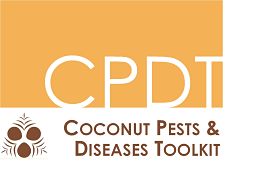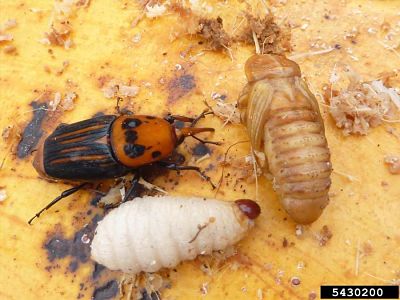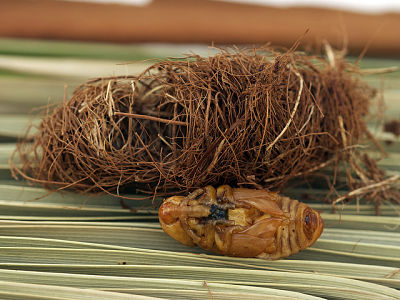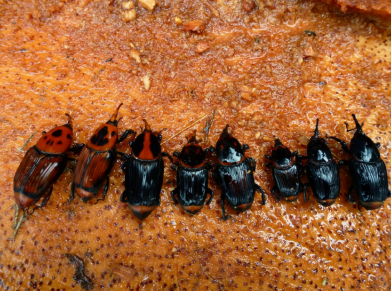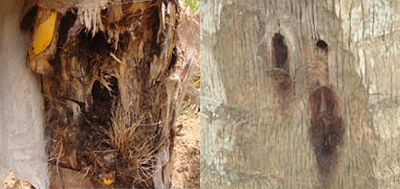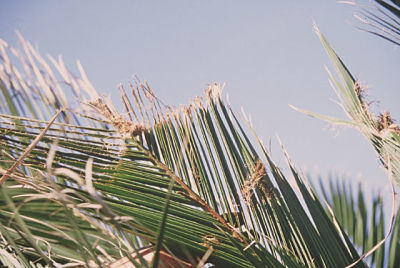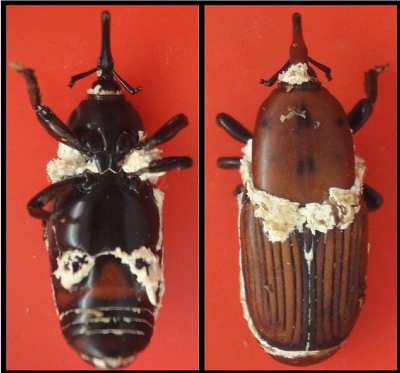Palm weevil
The red palm weevil is a major pest insect of coconut and other palms. Other palm weevils can cause damage to coconut. These are a HIGH risk pest in the Pacific.
Common nameRed palm weevil (RPW) |
Scientific nameRhyncophorus ferrugineus |
on this page: Life-cycle and identification : Symptoms : Impacts : Distribution : Prevention : Controlling palm weevil : Information sources and further reading
Life-cycle and identification
Weevils are a type of beetle. Like all beetles, palm weevils have a complete metamorphic life cycle, that is each stage of their life cycle looks completely different. The four stages of the beetle life-cycle are egg, larva, pupa and adult.
Often beetle eggs are difficult to find and beetle larvae are difficult to identify. Identification of adults is much easier.
Eggs : Larvae : Pupae : Adults
EggsAround 200-300 shiny, creamy-white eggs (3 mm by 1 mm) are laid in holes or wounds (made by other insects or knives) in the trunks or leaf stalks of palms. 2-5 days later the eggs swell and the larvae hatch out. LarvaeLarvae are legless grubs with creamy-white bodies and brown heads. They can grow up to 50 mm long and 20 mm wide. The grubs feed on the soft plant tissue on the inside of the palm trunk. Symptoms of larval feeding include holes in the bark with plant tissue sticking out. Grub feeding areas vary with palm age. In palms up to 5 years old grubs can be found throughout the palm from trunk base to crown. Between 5 and 15 years the grubs feed at the base of the crown and on older palms (15+ years) the grubs may be below or in the crown, or in the frond bases. PupaeWhen ready to pupate the larva spins a fibrous cocoon under the bark of the palm (see image on right). Pupation begins three days later and lasts for 12-20 days before the adult emerges. Pupae are around 35 mm long and 15 mm wide. They change from a shiny cream to brown colour with adult features. AdultsAdult weevils vary in colour but are generally reddish-brown with dark spots on the part behind their head. They are about 40 mm long and 15 mm wide. The beetles have long curved snouts. Male and female snouts vary. Males have short brown hairs at the tip of the snout. Female snouts are longer, slimmer and more curved. |
The creamy-white grub compared to the pupae and adult life stage (© Christina Hoddle, University of California, Riverside, Bugwood.org)
Pupa with distinct adult features and its fibrous cocoon (© Katja Schulz, Flickr)
Colour variation in red palm weevils (© Paul Rugman-Jones, University of California, Riverside) |
SymptomsInfestation of the red palm weevil is hard to detect on the outside of the palm until damage is severe on the inside. Palms may collapse and die if they are hollowed out by the weevil before the attack is detected. Look for chewed holes on frond bases and stem with signs of ejected chewed material and possibly brown liquid at the entrance. The crown may be wilting and there may be death of fronds and/or leaves may have straight tips rather than pointed tips. You might even be able to hear the weevils crunching and chewing if you listen closely! The South American palm weevil (Rhynchophorus palmarum) can also cause damage to palms, but mostly due to its relationship with the red ring nematode and red ring disease. |
Chewed holes with ejected material (top) and brown liquid (bottom) (© TNAU)
Straight edged leaves rather than pointed (© Michel Ferry, INRA ) |
Impacts
The red palm weevil is a major pest of coconut palms as both adults and grubs cause damage to the inside and outside of the palm. The economic impacts from damage is mainly from the cost of control and eradication of the weevil, removing infested palms and replanting.
Distribution
The red palm weevil can be found throughout the world. In the Pacific it is found in Papua New Guinea, Samoa, Solomon Islands, and Vanuatu.
Please check with your local biosecurity / quarantine or SPC for up-to-date distribution information.
Prevention
Most importantly, the International Guidelines for transfer of coconut germplasm should be strictly followed to prevent pests and diseases being moved to new locations.
The best form of prevention of red palm weevil is through high quarantine and biosecurity standards at the local, regional and international level.
It is difficult to control outbreaks or stop new generations of adults from flying off and setting up home in another palm. It is also hard to detect infested palms until severe damage has occurred.
For general information on preventing pests and diseases of coconut, see the Prevention section.
Controlling palm weevil
We strongly recommend an integrated pest management (IPM) approach to the control of all insects, where possible. This is a combination of methods (pesticides, physical controls such as site hygiene and biological controls) to minimise the use of pesticides and minimise the cost of control.
Integrated Pest Management (IPM)
The goal of IPM is to keep pest populations to a level below which they cause economic harm. IPM involves using multiple control options together for the economic control of pests (i.e. cultural, natural and chemical).
In an agricultural context the Food and Agriculture Organization defines IPM as "the careful consideration of all available pest control techniques and subsequent integration of appropriate measures that discourage the development of pest populations and keep pesticides and other interventions to levels that are economically justified and reduce or minimize risks to human health and the environment. IPM emphasizes the growth of a healthy crop with the least possible disruption to agro-ecosystems and encourages natural pest control mechanisms".
Cultural
Cleaning of infested palms is recommended by removing palm stems. First cut the stems and then bury them to reduce breeding grounds. To reduce the entry of weevils into the stem during and after harvest, cut the fronds where the leaflets begin.
Trapping with pheromones as an attractant has been widely used in surveillance as part of an Integrated Pest Management (IPM) strategy. The trapped beetles can then be killed. The pheromone can be used in a spot treatment combined with an insecticide in a 'lure and kill' technique.
NaturalPlatymeris laevicollis (red-eyed assassin bug) was a predatory insect originally released to control Coconut rhinoceros beetle. It feeds on other insects also, and it was found to prefer the red palm weevil. Beauveria bassiana (white muscardine fungus) and Metarhisium anisopliae (green muscardine fungus) are parasitic fungi to many insects. These may be useful controls as they have been seen growing on red palm weevil adults and larvae and causing death. The image on the right shows beetles infected with the fungus (the white patches). Eggs and larvae of red palm weevil are also known to be eaten by nymphs and adult earwigs (Chelisoches moio). Beauveria and Metarhizium can be purchased in bulk online at websites such as alibaba.com |
Spores of Beauveria bassiana parasitising an RPW adult (© Abid Hussain, King Faisal University, CABI) |
Chemical
Insecticide application on wounds and other injuries to the palm trunk may reduce entry into the palm. Trunk injections of insecticides have been suggested but are not recommended due to its economic costs and skill needed for application.
The use of bucket traps with sugarcane or coconut and added pheromone lures (Ferrolur, Ferrolure+, ferrugineol) is also recommended. This method is commonly used and currently the best method of reducing populations. Young, pregnant and other adult female weevils are caught at a higher ratio to males, which suggests trapping has a great impact on reducing future generations.
ChemTica International provides bucket traps and pheromone lures.
Information sources and further reading
Al-saroj et al. 2017. Efficacy of bait free pheromone trap (ElectrapTM) for management of red palm weevil, Rhynchophorus ferrugineus (Olivier) (Coleoptera: Curculionidae). Pest Management in Horticultural Ecosystems, 23, 1, 55-59.
CABI. 2018. Rhynchophorus ferrugineus (red palm weevil). [ONLINE]
Center for Invasive Species Research. 2017. Red Palm Weevil, Rhynchophorus ferrugineus (Olivier) (Coleopetera: Curculionidae). [ONLINE]
Chakravarthy et al. 2014. Efficacy of aggregation pheromone in trapping red palm weevil (Rhynchophorus ferrugineus Olivier) and rhinoceros beetle (Oryctes rhinoceros Linn.) from infested coconut palms. Journal of Environmental Biology, 35, 479-484
Department for Environment and Internal Affairs. 2016. Red palm weevil, Rhynchophorus ferrugineus. [ONLINE]
EPA. 2018. Beauveria bassiana strain GHA (128924) Fact Sheet. [ONLINE]
Faleiro et al. 2016. Integrated Pest Management (IPM) of Palm Pests. Integrated Pest Management in the Tropics, pp. 439-497
Ferry & Gómez. 2002. The Red Palm Weevil in the Mediterranean Area. Palms, 46(4): 172–178. [ONLINE].
Howard et al. 2001. Insects on Palms. Cabi publishing, pp. 1-414.
Hussain, Rizwan-ul-Haq, Al-Jabr. 2013. Red palm weevil: Understanding the fungal disease mechanism and host defense. Microbial Pathogens and Strategies for Combating Them: Science, Technology and Education; Formatex Research Center: Badajoz, Spain, pp.1278-1286.
Muhammad. 2017. Management Programs and Challenges in Red Palm Weevil (RPW) Control in the Asia and Pacific Countries. Food and Agriculture Organization (FAO), pp. 1-52.
Organic Soil Technology. 2018. Beauveria bassiana Entomopathogenic Fungi. [ONLINE]
PestNet. 2017. Coconut red palm weevil. [ONLINE]
Rugman-Jones et al. 2013. The Lesser of Two Weevils: Molecular-Genetics of Pest Palm Weevil Populations Confirm Rhynchophorus vulneratus (Panzer 1798) as a Valid Species Distinct from R. ferrugineus (Olivier 1790), and Reveal the Global Extent of Both. PLOS ONE, 8, 10, 1-15
Winotai. 2013. IPM of Important Insect Pests of Coconut. FAO, pp. 1-60.
content reviewed by Bob Macfarlane, Solomon Islands, September 2018
